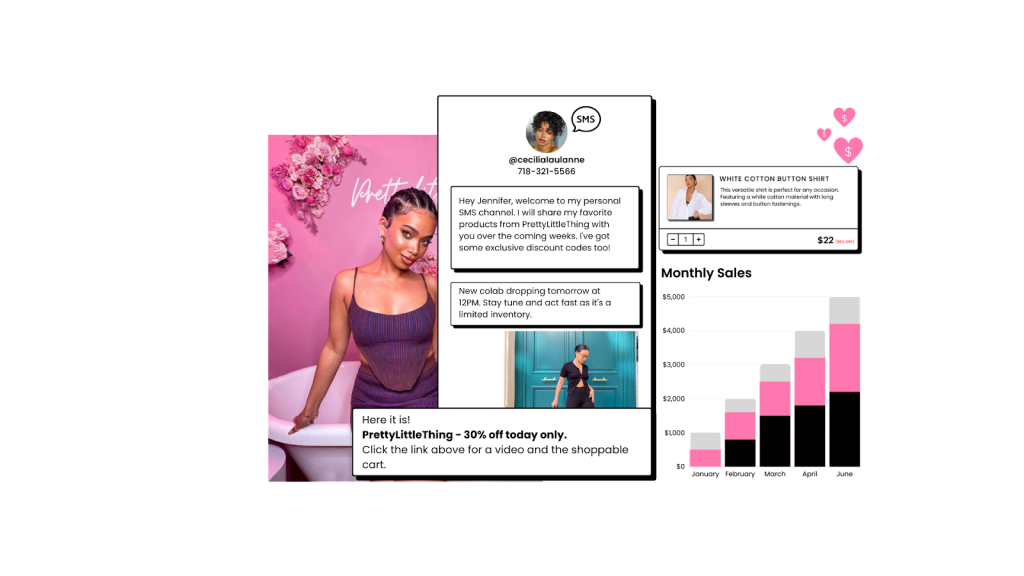Category: Instagram
Catarina is a fashion, beauty and lifestyle content creator. She’s worked with Outfit on a variety of campaigns, always producing beautiful and engaging content. Read through below about how she got started as a content creator and what inspires her work.
Introduce yourself
My name is Catarina, I am a lifestyle creator based out of San Francisco, CA. I’ve been in this industry for over 7 years now.
During the pandemic I started a small marketing boutique for dental and medical practices, I saw an opportunity where doctors and dentists can learn the value of content and influencers, so that’s grown into working with a network of practices in California.
How did you get into content creation/influencer marketing?
I started with my travel blog Wheres Catarina using it as an outlet where I can share my experiences with others alike. Traveling from country to country, uploading my photos into instagram back then when it was just a photo platform. I started receiving emails from tourism boards and hotels interested in working together that turned into many years as a travel blogger and has now transitioned over into the beauty and fashion creative space.
What inspires you in your work?
Dreams, I’m talking about the kind of dreams that people work towards in their life. Travel and careers and homes and creating things – seeing my community go after their dreams is inspiring.
That feeling of possibility not just for me but what I’m creating that makes something achievable, likely, or probable for my community.
Creativity, seeing something fresh, unique, and different inspires me to also be fresh, recreate and reinvent myself. It inspires me to avoid getting in a rut so I can better stand out and become a better version of myself.
The past is a form of inspiration, if you look at it in the right context. when I see the past, even the parts I don’t like, I use it as a source of inspiration.I try to look at the “good” I can take from the bad, and use the bad as a means of pushing me in the present to achieve even more. And to make sure those mistakes can never be repeated.
What do you love about using the Outfit platform?
I love working with an in-house team and building that long term relationship, gives both of us the opportunity to work closely together.
What do you envision for the future of influencers and creators?
I’d love to see influencers and creators alike collaborating together and Incorporating more storytelling into a collaboration while staying authentic.
Instagram has been making a lot of changes to the way that users interact with videos inside the app. The amount of changes and testing happening has left many of us reeling as we try to keep up. Hopefully we can help give some clarity to what exactly is and is not happening and also help you make some decisions around how you should be reacting as brands and creators who rely heavily on this platform.
Instagram’s updates to video
Towards the end of July the Head of Instagram, Adam Mosseri, revealed that Instagram will now only have one video format. All videos going forward will be Reels even if you are uploading them as normal posts. The platform has been making a lot of changes in this area in order to keep up with TikTok and minimize the amount of users moving over.
That isn’t the only way Instagram is emulating TikTok.
Many of us may have already noticed that the algorithm favoring video content overall and some users have even seen a new vertical version of their grids. After releasing these updates and getting some unhappy feedback from many users, Instagram reassured us that despite these changes to favor video they still want to do right by photos and as for that vertical grid, that was simply a test.
A petition called Make Instagram Instagram Again was started and was shared by celebrities like Kylie Jenner and Kim Kardashia, prompting the explanation from Head of Instagram, Adam Mosseri.
While users are resisting the change there is no doubt that short form video is a far more engaging form of content than still images. Based on the Sprout Social Index™ 2022, 66% of consumers found short-form video to be the most engaging type of in-feed social content.
Instagram themselves also noted that the content people share and engage with overall is naturally moving more towards video over time so they will have to cater to that.

What this means for brands and creators
To reiterate the sentiment from Instagram, this overall shift to video is just the beginning so brands and creators need to start making this shift too. For brands this means incorporating more video into your social media content strategies. If videos are making up less than about 50% of your posts then you may need to think about how you can start producing and sharing more of this kind of content.
Working with creators and influencers is a great way to get high quality, engaging video content to share on your own social media channels, and fast.
This means creators need to be focusing more on this area too.
Brands will be on the lookout for influencers and creators who can provide them with great video content for Reels and TikTok. So, if you want to be first in line for these partnerships you need to start showing off your skills in this area.
Both brands and creators will need to keep in mind that all video content should be optimized for the vertical Reel format. While you can still technically post square or horizontal/landscape videos this is not recommended. In a test run by Buffer they saw a 187% increase in views* for vertical video videos over square.
Our influencer platform streamlines the entire campaign process from start to finish for brands and creators. Brands can save time on influencer search and outreach, briefing, communication, and reporting. Influencers can get discovered by new brands, get briefed, submit content all inside the platform, we even take care of invoicing and you receive automatic payments instantly.
Sign up as a brand here.
Sign up as an influencer here.
*50% total watch time views.
Social commerce capabilities are showing up across many of the social media platforms we use everyday and some exciting new opportunities have come along with it.
If you haven’t already, it is time you learnt exactly what social commerce is, why your brand should be using it, and how to go about doing that.
What is social commerce?
Social commerce is the selling of goods directly on a social media platform, one form of social commerce you’ve most likely interacted with already is the ‘Shop’ tab on your Instagram app. This feature was revamped by Instagram in 2020 because they saw the need for retailers to boost sales and streamline the shopping process.
The easily accessible tab makes it easy for scrolling users to quickly turn into shoppers. Other platforms including Facebook and Pinterest also offer social commerce capabilities and TikTok, YouTube, and Twitter have begun experimenting with shop buttons so we expect to see more social commerce features from them popping up soon.
Here at Outfit we are working on our own form of social commerce that we are calling CreatorCart. This will utilize highly engaging SMS and allow your brand to sell across all channels via your curated influencer tribe. The results so far have incredible and we can’t wait to share more on this with you soon.
Why should my brand be using social commerce?
- Streamline the shopping experience
Online purchases tend to have a much higher cart abandonment rate. This is thought to be due to a number of factors including customers getting distracted on their way to purchase products and the smaller screen deterring people from buying, especially first time customers and bigger purchases. Social commerce attempts to combat these drop offs with a more streamlined, mobile-friendly experience. With less distractions and a more direct path to purchase there will be less opportunities for brands to lose customers during their online retail journey.
- Make shopping social
Social commerce makes shopping a more social and shareable experience. It makes it easy for users to share products they have discovered with friends privately in messages as well as publicly as links and posts on their social pages. This means there are even more opportunities for your products to be shared with potential new customers.
2. Millennials and Gen-Z’s love it!
The 18-34 demographic feel comfortable and familiar with these apps. They are already online and taking advantage of social commerce. Almost half of Gen-Zs and Millenials have made a purchase via social media and another 27% wanting to give it a try.

How do I get started?
- Getting set up
Instagram and Facebook both require you to set up your catalogs in Facebook Shop in order to start using these features. Once connected, partner platforms like Shopify will automatically sync up your store for you.
Pinterest also allows users to set up catalogs with Shopify but the process is more manual if your online store is on another platform. Pinterest does not offer purchasing in app right now so users will be redirected to your website.
Our own social commerce platform CreatorCart will plug directly into your Shopify store and there is no need to rely on any other social media channel in order to create customizable, sharable micro-sites for each influencer you are working with. This also means that you have complete control over all of the customer data and attribution.
Click here to apply for early access to CreatorCart.
2. Promote it with great content
Once you are set up it is time to start promoting this new way for your customers to shop. Create engaging content that drives users to your shop. Don’t forget to tag whatever products you are talking about in the content so people can immediately shop for those items. Influencer content will be the most engaging and it will also help you reach more people within your target audience. Outfit can help you with every step of the influencer marketing process so click here to get started planning your campaign today.
Influencer marketing has revolutionized the way we do marketing. We know great content is being created and that there is big potential for great results but gaining accurate insights is no mean feat.
After all of the effort spent setting up and executing an influencer campaign this step is often rushed or overlooked but this is one of the most important parts of your entire campaign.
Hopefully we can help to demystify this step and teach you how to uncover valuable information that will not only help future influencer campaigns but also your wider marketing activity.
1. Define your Goals
The relevance of what you measure will depend on what you’d like to get out of your marketing campaign. It’s crucial to identify this prior to starting your campaign so you can plan your campaign accordingly and understand whether or not the campaign was successful once complete.
Are you wanting to reach new customers? or you want more people to follow your brand on social media and engage with your content? Are you driving traffic to an online store? Or are you wanting people to visit your new brick and mortar location?
2. Understand key metrics
Brand Awareness
Now you’ve defined your goals, let’s dive deeper into what some of the key metrics are, what they mean, and why they are important.
Of course we all want to ultimately drive sales but it is important to remember if someone is never made aware of your brand then they will be very unlikely to make a purchase from it but if someone follows your brand and has been following you for a while they will be more likely to purchase from you, possibly even multiple times. Each metric also will also give you useful insights into what people are responding to so that you can learn about your audience and adapt accordingly.
If you are wanting to increase the overall awareness of your brand then you should be looking at your Reach, and Impressions.
Reach is the total number of unique people who have viewed your content or ad.
Impressions are the number of times your ad or content has been displayed, no matter if it was clicked or not or viewed by the same person more than once.
When creating your influencer campaign with Outfit, we’ll report on the total reach and impressions your campaign received and benchmark this against industry standards so that you can use that data to analyze results.
Engagement
Engagement and Interactions are a great way of knowing if the people you are targeting are actually taking interest in your content or product. If they aren’t engaging with your content you may be targeting the wrong people or you content might not be interesting enough to capture their attention.
Engagement consists of likes, comments, shares and profile clicks.
Interactions consist of sticker, hashtag, profile, and mention clicks.
Outfit will report on both of these metrics for the whole campaign as well as for each influencer. We can even split this into each location if you need us to so then you can easily gather and analyze the data.
Audience growth or the amount of followers you gained from the collaboration will give you a strong indication into how engaging the content is and the relevance of your brand to that audience. Mutual followers are good to note also, indicating they came directly from the collaboration. Outfit provides you with a summary of this metric against an industry benchmark once the campaign is complete.
Website visits can be tracked directly in app via Instagram stories but not posts. However, you can also use Google analytics and UTM links to help track this. It is important to also note any increase in overall traffic to your website around the time of the campaign too.
Conversion
UTMs are a great way to directly track conversions and what influencer they came from and so are affiliate discount codes and links.
As with traffic, you should note down and attribute an upturn in sales around the time of the campaign to because there will be customers who may not click directly through to make their purchase but still end up purchasing later on.
With the launch of our new influencer marketing tool CreatorCart attribution will become much easier and more accurate. Keep an eye out for more on this soon!
3. Look beyond the metrics
Influencers provide so much more value that simply clicks and conversions. They can help to improve overall brand loyalty, they can help you shift perceptions of your brand, and they are an authentic way to deliver important messages to your customers. They provide a way to deeply connect with the people you are targeting however you may want to do that.
They also provide create content for you to use for other marketing material. Make sure to be explicit about content usage in your briefs if this is your intention but many influencer create highly engaging and professional content that you could reuse elsewhere saving on potential production costs further down the track. If you receive a lot of great content you can use on your own channels then this should be a measure of success for your campaign too.
4. Use an influencer marketing platform
Using an influencer marketing platform means that the compiling of all of this data is done for you so you can save that time and use it elsewhere.
Outfit is an end-to-end influencer marketing platform, providing smart technologies for brands and agencies to seamlessly connect with creators to manage campaigns, amplify their message and attribute success. We have everything you need from influencer selection, easy payment processing and a full report of key metrics at the end of your campaign to understand your success.
Sign up to Outfit today, free of charge and discover how influencer marketing can amplify your next marketing campaign.

)
